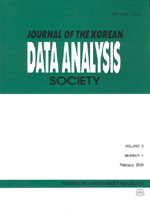출산자료 및 모형 별 출산율 예측 비교 연구
A Comparison Study for Forecasting Fertility Rate by Models and Data Types
- 한국자료분석학회
- Journal of The Korean Data Analysis Society (JKDAS)
- Vol.13 No.6
-
2011.122901 - 2914 (14 pages)
- 64

예측을 목적으로 출산력에 대한 모형화를 할 때에는 코호트자료와 기간자료를 사용할 수 있다. 일반적으로 코호트출산율을 모형화에 사용하는 것이 더 나은 것으로 알려져 있으나, 이는 자료의 신뢰도가 확보되었을 때를 전제로 하고 있다. 통계청에서는 ‘2006년 장래인구추계’를 실시할 때 출산력 모형화에 코호트출산율을 사용하였고, 이때 1950~1960년까지 6개의 완결코호트(1950~1955년)와 5개의 출생코호트(1956~1960년)가 사용되었다. 또한 코호트출산율은 구성과 유지에 어려움이 있는 것으로 알려져 있다. 이러한 불안정성 때문에 우리나라의 경우도 1950~1960년까지 출생코호트라면 자료의 신뢰도를 의심해보지 않을 수 없다. 그러므로 이 연구에서는 코호트출산율 자료의 점검을 통해 문제점을 확인하고 개선을 위하여 기간출산율, 합계출산율에 모두 적용할 수 있는 출산율모형들의 적용을 검토하고 특성을 비교하고자 한다. 실제로 이 두 자료에 대하여 일반화로그감마분포모형(generalized log-gamma distribution model, GLG)과 Peristera and Kostaki의 함수를 이용한 PKII모형 등을 적합, 예측하였다.
The cohort and the period data are available to forecast the fertility rate. In general, it is known that the cohort data are better to model the fertility rate than the period data. However, this depends on reliability of the cohort data. Stat Korea used the cohort fertility rate to model age specified the fertility rate in population projection 2006. At that time, totally 11 birth cohorts (1950~1960) were used to model age specified fertility rate, six of them were complete (1950~1955) and five of them were incomplete (1956~1960). Also, it is well known that the maintenance and administration of cohort data are difficult. Because of the instability, we need to inspect reliability of the birth cohort used in population projection 2006. Therefore, in this study, to find improved method for modeling the fertility rate, we verify fertility rate models applicable both cohort and period birth rate data. Actually, we fit and forecast the fertility rate using the cohort and period fertility rate data with generalized log-gamma distribution model and PKII model by Peristera and Kostaki function.
1. 서론
2. 우리나라 코호트출산율과 기간출산율 자료
3. 출산율 예측모형
4. 출산순위별 출산율 적합결과
5. 합계출산율 예측결과 비교
6. 결론
참고문헌
(0)
(0)